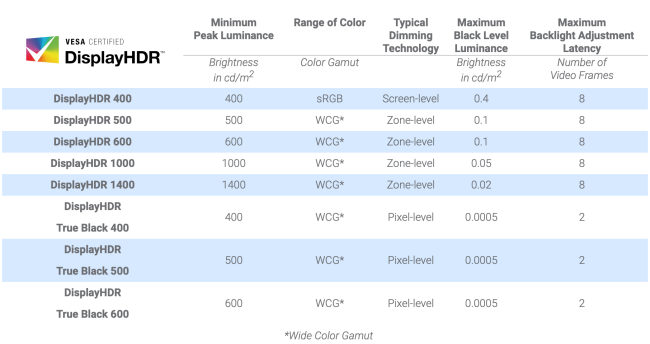Quick Links
High dynamic range (HDR) monitors are becoming mainstream, but their performance can vary widely. So how do you know what HDR performance level you are getting with a particular monitor? The VESA DisplayHDR certification hopes to solve this issue.
What Is HDR?
HDR allows a more lifelike visualization of images and videos. A display achieves HDR by representing brighter highlights, darker shadows, and a wider range of colors than SDR or standard dynamic range. Simply put, the HDR displays can showcase more realistic images and videos.
But as each display has different capabilities, like contrast ratio, peak brightness, and color coverage, their HDR performance also differs. For example, a monitor offering an excellent contrast ratio, high brightness level, and a broader range of colors will typically be better at HDR than a monitor with an average contrast ratio, low peak brightness, and limited color coverage.
Without standardized information, all this can confuse consumers, so Video Electronics Standards Association (VESA) introduced the DisplayHDR standard in 2017. The DisplayHDR offers an easy way for consumers to identify the HDR performance they will get with a display.
Certifying HDR Performance
DisplayHDR is an open standard with a fixed set of specifications to rate HDR quality. It is primarily targeted at monitors and laptop displays. With over two dozen companies participating in its development and deployment, the standard has seen widespread adoption.
At the standard's core are a performance test suite and associated tiers. Each tier has specific criteria for different HDR quality attributes, like luminance, color gamut, bit depth, and rise time. That said, the tiers are primarily defined by their peak luminance level, which is also reflected in the names.
The first iteration of the DisplayHDR standard---DisplayHDR version 1.0---was targeted at LCDs. But VESA followed it up with the DisplayHDR True Black version in 2019 that is meant for emissive displays like OLED.
DisplayHDR Tiers Explained
As of March 2022, there are eight DisplayHDR tiers, divided into two groups---five for LCDs and three for OLEDs.
DisplayHDR 400
DisplayHDR 400 is the minimum rating of the standard. A monitor needs to have at least 400 nits of peak brightness, 95% coverage of sRGB color space, 8-bit color depth, and global dimming to qualify for it.
Although many monitors and displays in the market have the DisplayHDR 400 certification, the HDR performance of these monitors is nothing to boast about. Due to the lack of local dimming, peak brightness slightly higher than SDR displays, and lack of wide color gamut, DisplayHDR 400-rated displays are only marginally better than the SDR displays.
DisplayHDR 500
The DisplayHDR 500 rating is a slight improvement over the DisplayHDR 400 specification. However, it requires the display to have local dimming, 10-bit color depth, and over 90% coverage of DCI-P3 color space. As of March 2022, only two laptops have DisplayHDR 500 rating.
DisplayHDR 600
The 600 level of the DisplayHDR standard has essentially the same HDR attributes as the 500 level, except for the brightness. However, DisplayHDR 600 rated monitors can offer decent HDR performance thanks to significantly higher peak brightness than SDR displays.
DisplayHDR 1000
The DisplayHDR 1000 rating is a big jump from the 600 level. Although it has the exact color gamut requirements as 500 and 600 levels, the 1000 rating requires the display to have lower black levels than 600. As a result, the DisplayHDR 1000 rated monitors better preserve darker details in HDR content.
In addition, the high peak brightness requirement of this rating means the monitors are also better at representing small highlights. Overall, the DisplayHDR 1000 rated monitors are great for HDR content consumption and creation.
DisplayHDR 1400
The 1400 level is the highest offered by the DisplayHDR certification. It requires an even wider color gamut with 99% coverage of BT.709 and 95% of DCI-P3 color spaces, better contrast than 1000 level, and very high peak and sustained brightness levels.
DisplayHDR 1400 rated monitors have the best HDR performance. But this rating is only available on very few displays.
DisplayHDR True Black 400, 500, and 600
The DisplayHDR True Black certification is designed for self-emissive display technologies, like OLED. Since OLED displays don't need local dimming, have perfect black levels and an almost infinite contrast ratio, the levels of DisplayHDR True Black certification are primarily different in terms of their brightness.
Thanks to their exceptional contrast ratio, the DisplayHDR True Black-rated displays can deliver a better HDR experience even at relatively lower brightness levels of 400 and 500, unlike LCD monitors.
How to Check Whether a Monitor Is DisplayHDR Certified
You can identify a DisplayHDR certified monitor or laptop with the VESA certified DisplayHDR logo in the marketing material or the product box. The logo will always include the tier information, like DisplayHDR 400 or DisplayHDR 1000.
You can also use the certified products section of the official DisplayHDR website to look for the certification status of a particular monitor. The website will mention which specification version was used when the display was certified. There are two major specification versions---1.0 and 1.1---the latter being the newest and more rigorous than the original.
Note that monitors simply marketed as HDR-400 or HDR-600 without the DisplayHDR branding or logo are not officially certified products. So while they may be capable of supporting HDR, their performance hasn't passed any DisplayHDR certification.
While VESA-certified labs test monitors to rate their HDR performance, the industry group has released a free DisplayHDR Test Tool for the public that you can use to verify HDR performance at home. It's available via Microsoft Store and GitHub for Windows users. This can help avoid situations where the sample unit sent for certification performs differently than the retail unit.
DisplayHDR vs. HDR10
HDR10 and DisplayHDR are pretty different. While the former is a high dynamic range format, the latter is just a certification of a display's HDR quality. Since DisplayHDR is not a format, you won't see content mastered in it. On the other hand, HDR10 is used to master content to look more lifelike, and it requires a compatible display to visualize that content. A monitor needs to be able to represent HDR10 content to get any level of DisplayHDR certification.
For now, DisplayHDR certification doesn't require a monitor or laptop screen to support any other HDR format apart from HDR10. But it doesn't stop monitors from supporting other HDR formats. As a result, some monitors are DisplayHDR certified and support other HDR formats like Dolby Vision and HLG.
Helpful, But There Is Room for Improvement
In a market filled with marketing jargon and unverifiable performance metrics, DisplayHDR helps give you, as a potential buyer, some idea about the HDR performance of a monitor. But it's not perfect. Thanks to the relatively lenient requirements, DisplayHDR 400-certified monitors, a significantly large chunk of the market, provide only average HDR performance. That said, DisplayHDR is still a relatively new standard that can hopefully mature over time.





